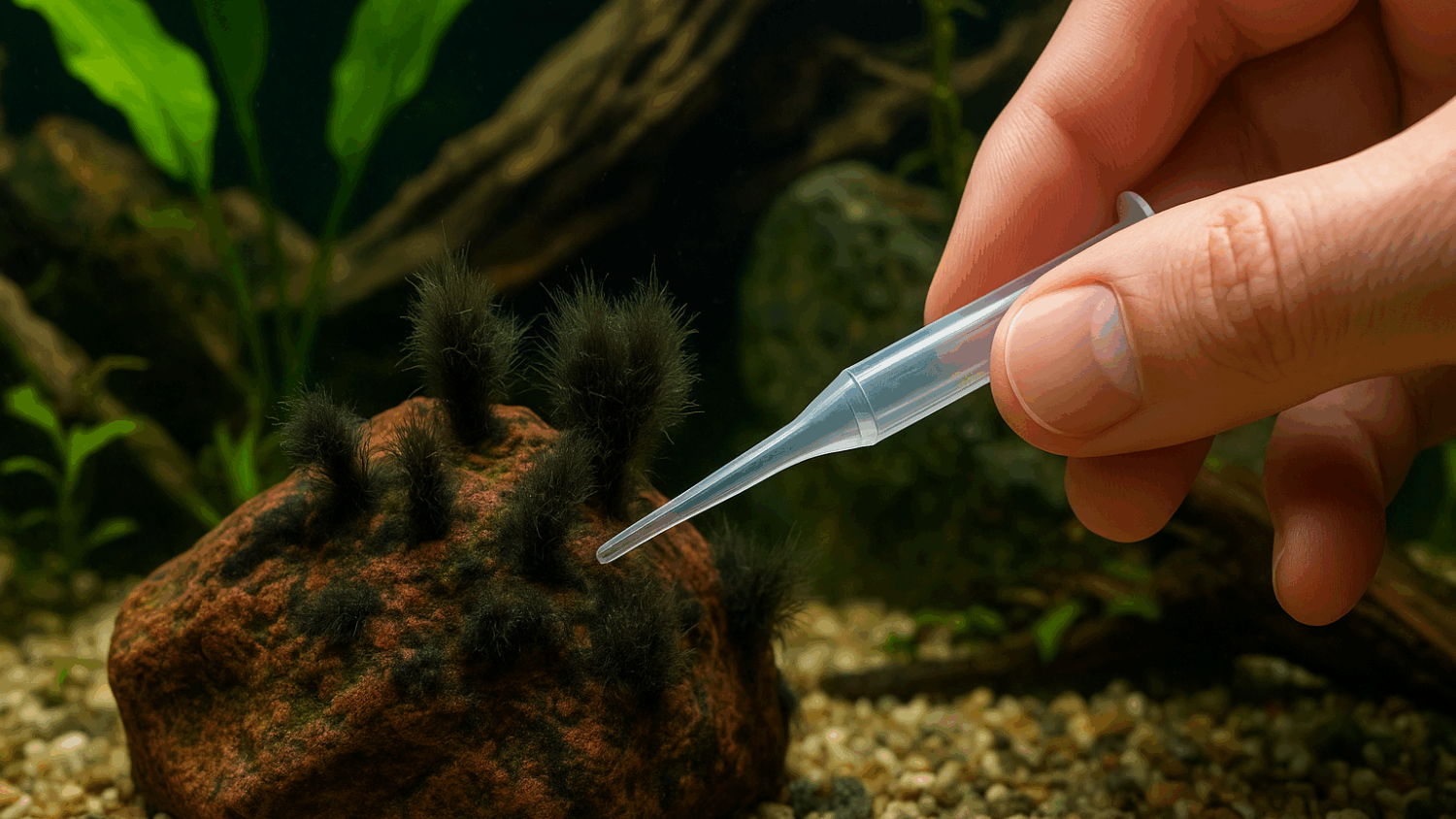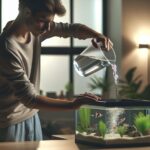How to Get Rid of Black Beard Algae From Your Aquarium
If you’ve noticed dark, fuzzy tufts appearing in your aquarium, you’re probably dealing with Black Beard Algae (or BBA for short). The good news? It’s manageable. I’ll walk you through the steps to remove BBA from your tank, explain why it shows up, and show you how to keep it from coming back.
What Is Black Beard Algae (BBA)?
Understanding What Causes Black Beard Algae
Black Beard Algae (a.k.a. BBA) gets its name from those dark, brush-like tufts it forms, but here’s the thing: it’s not always black. This filamentous algae (which belongs to the genus Audouinella and related groups in the red-algae family) can actually show up in shades ranging from dark green to grey to deep black. You’ll typically find it clinging to plants, rocks, and pretty much any surface it can grab onto.
Now, what’s really interesting is that BBA tends to move in when your plants are struggling. When plants are stressed, maybe from changing water conditions or just getting older, they release certain metabolites that basically send out a welcome signal to algal spores.
And even if you’ve got a flourishing planted tank, you’re not completely off the hook. Certain strains of BBA have a thing for slow-growing plants like Anubias or Bucephalandra, as well as hardscape surfaces. So, even healthy plants can end up hosting this unwelcome guest.
How to Identify Black Beard Algae vs Other Types of Algae
BBA usually starts small—just short stubble along leaf edges that you might barely notice at first. Give it time, though, and those little patches develop into longer, bushy tufts that look like tiny brushes clinging to everything. You’ll often find it settling onto slow-growing plants, driftwood, and rocks, but it’s not picky—it’ll even latch onto filter outlets and tubing if given the chance.
If you’re wondering whether you’re actually looking at BBA or something else, here’s a quick way to tell: Staghorn Algae has a wiry, branching structure, while BBA is thicker and more tufted, with that distinctive bushy appearance.
The good news is BBA won’t directly harm your fish. The bad news? When it spreads across plant leaves, it blocks light and reduces photosynthesis, which can gradually weaken your plants and throw off your tank’s entire ecosystem balance.
Why BBA is a Common Problem in Freshwater Aquariums
So why does BBA show up so often in aquariums? Well, it’s partly because those hardy little spores are excellent hitchhikers; they sneak in on new plants, décor, or even substrate without you realizing it.
Then there’s the irony of high-tech planted tanks. You’re doing everything right, injecting CO₂ and running bright lights, but pushing your plants that hard can actually create the perfect conditions for BBA to thrive. It’s a bit of a balancing act.
And let’s be honest: most tanks go through periods of instability. Maybe your parameters fluctuate, or your nutrients get out of whack, or something else stresses your plants. When that happens, BBA sees an opportunity and takes it. Basically, any time your plants are struggling, BBA is right there ready to move in.
What Causes Black Beard Algae to Grow?
Imbalance in Lighting Duration or Intensity
Look, light alone won’t necessarily cause BBA, but it definitely plays a supporting role. If you’re running your lights too long, too bright, or your tank’s catching direct sunlight, you’re giving BBA the energy it needs to spread. Consistency matters here; erratic lighting schedules can throw everything off balance.
Fluctuating CO₂ Levels
This is a big one, especially for those of us who like planted tanks. Unstable or low CO₂ is one of the main culprits behind BBA outbreaks. When your plants can’t efficiently use the light and nutrients available because CO₂ keeps fluctuating, BBA happily fills that gap. And here’s something interesting: BBA often shows up right during transition periods, like when your CO₂ cylinder runs out and you’re installing a new one. That brief window of instability is all it takes for BBA to get a foothold.
Excess Nutrients and Uneaten Fish Food
High levels of nitrate, phosphate, and organic waste from uneaten food create a feast for algae, BBA included. Now, you might hear that high phosphate is the villain here, but the research is actually pretty mixed on that. What seems to matter more is overall instability: fluctuations in flow, CO₂, and nutrients together create the problem, rather than any single parameter being too high.
Poor Water Circulation and Tank Maintenance
BBA loves stagnant water. Those quiet spots in your tank with little to no flow? Perfect real estate for algae to settle in and grow. Good circulation actually helps disrupt algal attachment before it becomes a problem. And when you let old plant leaves hang around too long or detritus piles up in the corners, you’re basically rolling out the welcome mat for BBA.
How to Remove Black Beard Algae from Your Aquarium
Manual Removal Techniques
Sometimes you just need to roll up your sleeves. Start by trimming away any plant leaves that are heavily covered in BBA, especially on slow-growing plants where it tends to really dig in. For your décor, rocks, and driftwood, pull them out and give them a good scrub with a soft brush or pick off the tufts with tweezers. Hard surfaces like glass can be tackled with a toothbrush or algae scrubber. It’s not glamorous work and it takes time, but it does give you immediate results.
Chemical Treatments (Use with Caution)
If you’re feeling brave, spot-treating with diluted hydrogen peroxide can actually kill BBA on hard surfaces: just use a plastic syringe or pipette to apply it directly. The 3% stuff you can pick up at the store or chemist is more than enough. Here’s the catch: you need to be extremely careful around plants and fish. Liquid carbon products like Seachem Excel can also help by giving your plants an alternative carbon source when they’re struggling to keep up (spot-treating works well for this one too). When using either treatment, try temporarily turning off the filter to give it a minute or two to work on the spot before the water circulates again. Just remember, these treatments are tools, not magic bullets. If you don’t address what’s causing the BBA in the first place, it’ll just come right back.
Natural Control Methods
There’s a gentler approach that can work really well: bringing in some algae-eating allies (more on the specific species in a bit) to help keep things under control. But the real secret weapon? Healthy, fast-growing plants. When your plants are thriving and nutrient-rich, they’ll outcompete BBA for light and resources. Here’s what’s fascinating: when plants really dominate your tank and efficiently use available nutrients, BBA struggles to find those little niches where it can take hold. Pair that with consistent maintenance and monitoring, and you’re creating an environment where BBA simply can’t get comfortable.
Best Algae-Eating Fish and Invertebrates for Black Beard Algae
Siamese Algae Eater
When it comes to actually eating BBA, the Siamese Algae Eater (the true species: Crossocheilus siamensis) is your best bet. It’s one of the few fish that will reliably munch on this stuff. Just be careful when you’re buying, there are some look-alike species out there that won’t do the job. Make sure you’re getting the real deal, because only the genuine article has that proven track record against BBA.
Amano Shrimp
Amano Shrimp have earned their reputation in the planted tank world, and for good reason. They’re fantastic at consuming algae, especially the dead remnants after you’ve done a chemical treatment on BBA. Now, they won’t tackle thick, living BBA quite as aggressively as a Siamese Algae Eater will, but they’re excellent for long-term maintenance and keeping things tidy once you’ve got the upper hand.
Nerite Snails
Nerite Snails are your go-to for keeping glass and hard surfaces clean. They’ll graze away steadily at algae buildup, which definitely supports your overall battle plan. Just don’t expect them to solve your BBA problem on their own; they work best when paired with manual removal and better tank conditions.
Other Compatible Tank Mates
You’ll find plenty of other bottom dwellers and algae-eaters out there, and while they might help with general algae issues, most won’t make much of a dent in thick, tufted BBA. The key here is thinking of these creatures as part of your overall strategy, not a single magic solution.
How to Prevent Black Beard Algae from Coming Back
Maintain Stable Lighting and CO₂ Schedule
Consistency is your friend here. Set your lights on a timer and stick to a regular schedule—no random fluctuations. If you’re running CO₂, keep a close eye on those levels and avoid any sudden drops or interruptions (remember, those transition periods are when BBA loves to strike). Until your tank stabilizes, keep your photoperiod reasonable—somewhere around 6 to 8 hours a day works well for most setups.
Perform Regular Water Changes
Regular water changes, weekly or every two weeks, around 25 to 30%, helps to flush out the excess nutrients and organic waste that algae feeds on. The key word here is “regular.” Those big, infrequent water changes might seem efficient, but they can actually shock your system and stress out your plants, which just opens the door for BBA.
Avoid Overfeeding and Overfertilizing
It’s tempting to spoil your fish, but only feed them what they’ll eat in a few minutes. Anything left over just breaks down and adds more nutrients to the water. The same goes for fertilizers; yes, your plants need them, but more isn’t always better. If you’re overdoing it or your plants aren’t efficiently using what you’re adding, you’re basically feeding the BBA instead.
Keep a Balanced Ecosystem with Live Plants
A tank full of healthy, fast-growing plants is your best defense. Stem plants and carpeting plants are particularly good at this: they’ll aggressively use up nutrients and light, leaving little for BBA to work with. Keep up with regular trimming, remove those older leaves, and encourage new growth. When your plants are taking up all the available space and resources, there’s simply no “free real estate” left for BBA to colonize.
Common Mistakes to Avoid When Dealing with BBA
Using Harsh Chemicals Without Research
It’s tempting to reach for the strongest algaecide you can find when you’re frustrated, but hold on. Dumping harsh chemicals into your tank without checking how they’ll affect your plants, shrimp, fish, or even your filter can do way more harm than good. Remember, BBA treatment only really works when it’s part of a bigger picture: fixing the underlying issues, not just nuking the symptoms.
Ignoring Root Causes of Algae Growth
Sure, scrubbing away algae feels productive and your tank looks better instantly. But here’s the thing: if you haven’t addressed what’s actually causing the BBA (whether that’s poor flow, unstable CO₂, lighting issues, or nutrient imbalances) you’re just buying yourself a little time. The algae will be back, and you’ll be right back where you started.
Over-cleaning and Stressing Fish or Plants
I get it, seeing BBA spread can trigger some serious anxiety. But some hobbyists react by cleaning too aggressively, and that can backfire. You might end up removing beneficial bacteria or seriously stressing your fish and plants in the process. The better approach? Gentle, regular maintenance. Think steady progress, not emergency overhaul.
Some Common Questions
Can black beard algae kill my plants?
Not directly, but it can definitely lead to that outcome. When BBA completely covers a leaf, it blocks light from reaching the plant’s surface and shuts down photosynthesis. Over time, this weakens the plant and can eventually kill it. So while BBA isn’t actively attacking your plants, it’s essentially suffocating them.
How long does it take to get rid of BBA?
That’s the question everyone wants a quick answer to, but honestly, it depends. How established is it? How quickly can you fix the underlying conditions? How aggressive are you willing to be with treatment? In lighter cases, you might see real improvement within a few weeks. Tougher infestations can take a solid 1-2 months of consistent effort before you’re in the clear.
Is black beard algae harmful to fish?
Generally speaking, no, BBA itself isn’t toxic to your fish. But here’s the indirect problem: when it gets out of control, it degrades plant health and can impact water quality through excess organic matter breaking down. So while the algae won’t directly hurt your fish, the downstream effects of a heavy infestation might.
Can I completely prevent it from returning?
You can stack the odds heavily in your favor, but “completely” is a tough promise to make. BBA spores exist in nature and can find their way into your tank through new plants, substrate, or décor. That said, with stable parameters, robust plant growth, and consistent maintenance, you can definitely keep it under control long-term. Think of it as management rather than total elimination.
Look, BBA is one of those challenges that almost every aquarist faces at some point. It’s not a sign you’re doing something wrong—it’s just part of the learning curve. The key is understanding what’s happening in your tank and responding thoughtfully rather than reactively. Tackle the root causes, stay patient with the process, and remember that a healthy, balanced aquarium is always your best defense. You’ve got this.




